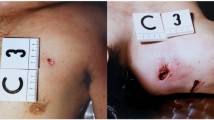Abstract
In sharp force injury cases, the presence of hesitation marks or defense wounds figures among useful characteristics in the distinction of suicide and homicide. However, there are very few systematic comparative studies of hesitation marks and defense wounds in the forensic literature. This study was thus undertaken to systematically compare features of hesitation marks and defense wounds, with a particular emphasis on dispersion patterns. Over a 5-year period, all suicidal and homicidal sharp force cases were retrospectively reviewed for hesitation marks and defense wounds. A total of 58 suicides (7 women; 51 men) and 149 homicides (59 women; 60 men) were found, of which 74% (n = 43) were positive for hesitation marks and 61% (n = 91) for defense wounds. On the upper limbs, hesitations marks were more often observed on the anterior aspect of the limb, while defense wounds were equally distributed on the anterior and posterior aspect. For hand lesions, hesitation marks were generally located on one side only, while defense wounds more commonly involved both sides. No left or right predominance was observed in hesitations marks or defense wounds. Defense wounds were more widely distributed on the upper limbs than hesitation marks.



Similar content being viewed by others
References
DiMaio VJ, DiMaio D. Wounds caused by pointed and sharp-edged weapons. Forensic Pathol. 2nd ed. Boca Raton, FL: CRC Press; 2001. p. 187–228.
Spitz WU. Sharp force injury. In: Spitz WU, editor. Spitz and Fisher’s medicolegal investigation of death. 4th ed. Springfield, IL: Charles C Thomas; 2006. p. 532–606.
Bohnert M, Hüttemann H, Schmidt U. Homicides by sharp force. In: Tsokos M, editor. Forensic pathology reviews, vol. 4. Totowa, NJ: Humana Press Inc.; 2005. p. 65–89.
Mazzolo GM, Desinan L. Sharp force fatalities: suicide, homicide or accident? A series of 21 cases. Forensic Sci Int. 2005;147S:S33–5.
Gill JR, Catanese C. Sharp injury fatalities in New York city. J Forensic Sci. 2002;47:554–7.
Karlsson T. Homicidal and Suicidal Sharp Force Fatalities in Stockholm, Sweden. Orientation of Entrance Wounds in Stabs Gives Information in the Classification. Forensic Sci Int. 1998;93:21–32.
Rouse DA. Patterns of stab wounds: a six-year study. Med Sci Law. 1994;34:67–71.
Bajanowski T, Varro A, Sepulchre MA. Tod durch scharfe Gewalt. Kriminologische und kriminalistische Aspekte. Arch Kriminol. 1991;187:65–74.
Byard RW, Klitte A, Gilbert JD, James RA. Clinicopathologic features of fatal self-inflicted incised and stab wounds. A 20-year study. Am J Forensic Med Pathol. 2002;23:15–8.
Karger B, Niemeyer J, Brinkmann B. Suicides by sharp force: ttypical and atypical features. Int J Legal Med. 2000;113:259–62.
Ohshima T, Kondo T. Eight cases of suicide by self-cutting or stabbing: consideration from medico-legal viewpoints of differentiation between suicide and homicide. J Clin Forensic Med. 1997;4:127–32.
Start RD, Milroy CM, Green MA. Suicide by self-stabbing. Forensic Sci Int. 1992;56:89–94.
Chadly A, Marc B, Paraire F, Durigon M. Suicidal stab wounds of the throat. Med Sci Law. 1991;31:355–6.
Karlsson T, Ormstad K, Rajs J. Patterns in sharp force fatalities–a comprehensive forensic medical study: part 2. suicidal sharp force injury in the stockholm area 1972–1984. J Forensic Sci. 1988;33:448–61.
Inoue H, Ikeda N, Ito T, Tsuji A, Kudo K. Homicidal sharp force injuries inflicted by family members or relatives. Med Sci Law. 2006;46:135–40.
Gupta A, Rani M, Mittal AK, Dikshit PC. A study of homicidal deaths in Delhi. Med Sci Law. 2004;44:127–32.
Rogde S, Hougen HP, Poulsen K. Homicide by sharp force in two scandinavian capitals. Forensic Sci Int. 2000;109:135–45.
Karlsson T. Sharp force homicides in the Stockholm Area, 1983–1992. Forensic Sci Int. 1998;94:129–39.
Hunt AC, Cowling RJ. Murder by stabbing. Forensic Sci Int. 1991;52:107–12.
Ormstad K, Karlsson T, Enkler L, Rajs J. Patterns in sharp force fatalities–a comprehensive forensic medical study. J Forensic Sci. 1986;31:529–42.
Vanezis P, West IE. Tentative injuries in self stabbing. Forensic Sci Int. 1983;21:65–70.
Metter D, Benz D. Abwehrverletzungen bei Tötungsdelikten durch scharfe Gewalteinwirkung. Z Rechtsmed. 1989;102:277–91.
Katkici U, Ozkok MS, Orsal M. An autospy evaluation of defence wounds in 195 homicidal deaths due to stabbing. J Forensic Sci Soc. 1994;34:237–40.
Sauvageau A, Yesovitch R, Racette S. An unusual case of suicide by broken glass pierced through the buttocks. Med Sci Law. 2005;45:81–4.
DiMaio VJ, DiMaio D. Interpretive toxicolocy: drug abuse and drug deaths. Forensic Pathol. 2nd ed. Boca Raton, FL: CRC Press; 2001. p. 507–46.
Schmidt U, Pollak S. Sharp force injuries in clinical forensic medicine-findings in victims and perpetrator. Forensic Sci Int. 2006;159:113–8.
Author information
Authors and Affiliations
Corresponding author
Rights and permissions
About this article
Cite this article
Racette, S., Kremer, C., Desjarlais, A. et al. Suicidal and homicidal sharp force injury: a 5-year retrospective comparative study of hesitation marks and defense wounds. Forensic Sci Med Pathol 4, 221–227 (2008). https://doi.org/10.1007/s12024-008-9046-8
Received:
Accepted:
Published:
Issue Date:
DOI: https://doi.org/10.1007/s12024-008-9046-8




